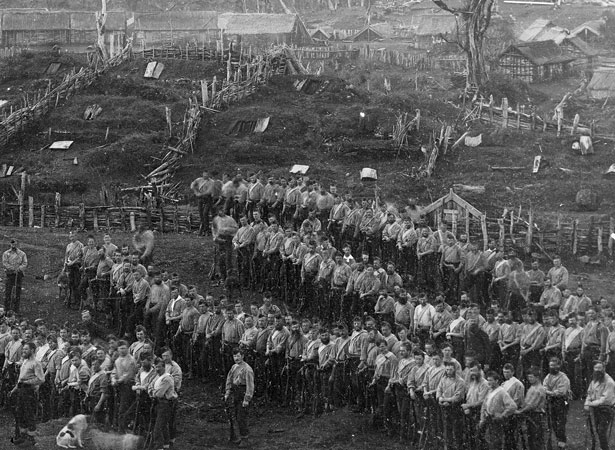 |
| The death ship SS Tulane pn163 |
On 7 November 1918, the New Zealand passenger and cargo ship Talune arrived at Apia from Auckland. On board were people suffering from pneumonic influenza, a highly infectious disease already responsible for hundreds of thousands of deaths around the world. Although the Talune had been quarantined in Fiji, no such restrictions were imposed in Samoa. Sick passengers were allowed to disembark.
The total number of deaths attributable to influenza was later estimated to have reached 8500, or 22% of the population. According to a 1947 United Nations report, it ranked as ‘one of the most disastrous epidemics recorded anywhere in the world during the present century, so far as the proportion of deaths to the population is concerned’.The disease spread rapidly through the islands. Samoa's disorganised local health facilities and traumatised inhabitants were unable to cope with the magnitude of the disaster and the death toll rose with terrifying speed. Grieving families had no time to carry out traditional ceremonies for their loved ones. Bodies were wrapped in mats and collected by trucks for burial in mass graves.
Survivors blamed the New Zealand Administrator, Lieutenant-Colonel Robert Logan, for failing to quarantine Talune and for rejecting an offer of medical assistance from American Samoa. A Royal Commission called to enquire into the allegations found evidence of administrative neglect and poor judgement.
Logan seemed unable to comprehend the depth of feeling against him and his administration. He left Samoa in early 1919 and did not return. The new Administrator, Colonel R.W. Tate (1920-23), was left to cope with survivors' immense grief and ongoing resentment.
[It is] temporary and, like children, they [Samoans] will get over it provided they are handled with care... They will later on remember all that has been done for them in the previous four years...
Logan's report on the administration of Western Samoa, 8 August 1919, IT 1/1/1D
The influenza pandemic had a significant impact on New Zealand's administration of Samoa. Many older matai died, making way for new leaders more familiar with European ways. For survivors, the incident was seared into memory. It became the foundation upon which other grievances against the New Zealand administration would be built.
■ Monday was the 37th anniversary of the invasion of Parihaka on the slopes of Taranaki. I wonder how many New Zealanders have ever heard of it?
Invasion of pacifist settlement at Parihaka5 November 1881

Armed Constabulary units at Parihaka, 1881 (Alexander Turnbull Library, PA1-q-183-19)
About 1600 government troops invaded the western Taranaki settlement of Parihaka, which had come to symbolise peaceful resistance to the confiscation of Māori land.
Founded in the mid-1860s, Parihaka was soon attracting dispossessed and disillusioned Māori from around the country. Its main leaders were Te Whiti-o-Rongomai and Tohu Kākahi, both of the Taranaki and Te Ātiawa iwi.
When in May 1879 the colonial government moved to occupy fertile land in the Waimate Plains that had in theory been confiscated in the 1860s, Te Whiti and Tohu developed tactics of non-violent resistance.
Ploughmen from Parihaka fanned out across Taranaki to assert continuing Māori ownership of the land. The government responded with laws targeting the Parihaka protesters and imprisoned several hundred ploughmen without trial.
Following an election in September 1879, the new government announced an enquiry into the confiscations while sending the ploughmen to South Island gaols. In 1880 the West Coast Commission recommended creating reserves for the Parihaka people. Meanwhile, the government began constructing roads through cultivated land. Men from Parihaka who rebuilt their fences soon joined the ploughmen in detention.
The prisoners were released in early 1881. After ploughing resumed in July, Sir John Hall’s government decided to act decisively while Governor Sir Arthur Gordon was out of the colony. A proclamation on 19 October gave the ‘Parihaka natives’ 14 days to accept the reserves offered or face the consequences.
On 5 November, 1600 volunteer and Armed Constabulary troops marched on Parihaka. Several thousand Māori sat quietly on the marae as singing children greeted the force led by Native Minister John Bryce. The Whanganui farmer had fought in the campaign against Tītokowaru (see 9 June) and viewed Parihaka as a ‘headquarters of fanaticism and disaffection’. Bryce ordered the arrest of Parihaka’s leaders, the destruction of much of the village and the dispersal of most of its inhabitants.
Pressmen, officially banned from the scene by Bryce, were ambivalent about the government’s actions, but most colonists approved. Te Whiti and Tohu were detained without trial for 16 months. The government managed to delay for several years the publication in New Zealand of the official documents relating to these events.
Note
The text for both anniversaries is from NZHistory.govt.nz. See hyperlinks.
No mention of Parihaka was made in NZ school history classes until relatively recently. -- ACW
The text for both anniversaries is from NZHistory.govt.nz. See hyperlinks.
No mention of Parihaka was made in NZ school history classes until relatively recently. -- ACW

No comments:
Post a Comment